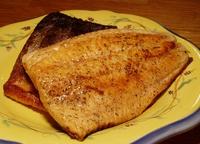
 Once upon a time, I seared my first piece of fish. Since All-Clad was (an still is) my all time favorite skillet, I used it for this very important task and lo and behold ended up with a disaster. The fish got so stuck, I barely wrestled it out of All-Clad's grip. From that day on, I've only seared my fish in non-stick skillets and lived happily ever after. Until one day, a suspicion got into my mind that there must be other ways to sear fish. After all, Teflon was only discovered in 1938, and I am sure people seared fish long before that.
Once upon a time, I seared my first piece of fish. Since All-Clad was (an still is) my all time favorite skillet, I used it for this very important task and lo and behold ended up with a disaster. The fish got so stuck, I barely wrestled it out of All-Clad's grip. From that day on, I've only seared my fish in non-stick skillets and lived happily ever after. Until one day, a suspicion got into my mind that there must be other ways to sear fish. After all, Teflon was only discovered in 1938, and I am sure people seared fish long before that.Today, I found out the answer to this persistent question. Cast iron works every bit as well as Teflon for producing perfectly crisp skin and golden flesh -- not surprising, considering its reputation as Grandpa of non-stick. Why might you ask did it take me 5 years to find out. Because I didn't own a cast iron pan. Feel free to gasp, shake your head, or simple leave this blog at this point. I know, I know. How could a real cook not own a cast iron pan? Well, I have wrist problems, and cast iron pans aren't exactly light. Whenever I tried to hold one in a kitchen store, my wrist was not a happy camper.
Last weekend I finally gave in to the temptation. I saw this beautiful cast iron pan at the Natick, MA farmer's market and couldn't help it. It was an old Griswold pan and somehow it seemed lighter to me than the Lodge pans sold at most kitchen stores. It needed a little tender love and care. But after reseasoning it, and a few therapeutic fryings of bacon and duck, it was ready for the fish test. No cheating with tuna or swordfish -- those are so dense you can sear them in anything. The deciding fish was going to be arctic char that is slender and delicate. I cooked half of the fish in a non-stick pan and the other half in a cast iron. Here are the results.


Neither skin side nor flesh side stuck and the char came out beautifully browned. If you are curious, the left one is from cast iron and the right one from Teflon. Both pans worked so well, that I can't decide which one I like more.

1 comment:
Glad you finally found a cast iron frypan you liked. :o) You're right, by and large the old Griswolds are going to be lighter weight than modern Lodge, though an old Lodge can be very nicely balanced and nearly as light as a Griswold. I have about 40 pans that all clamor for their turn on the fire.
Post a Comment